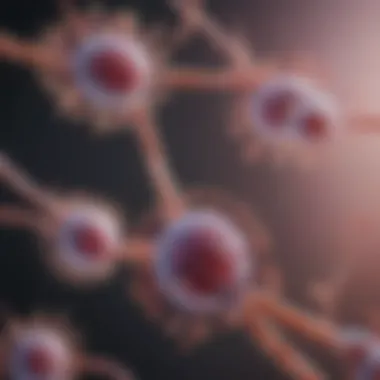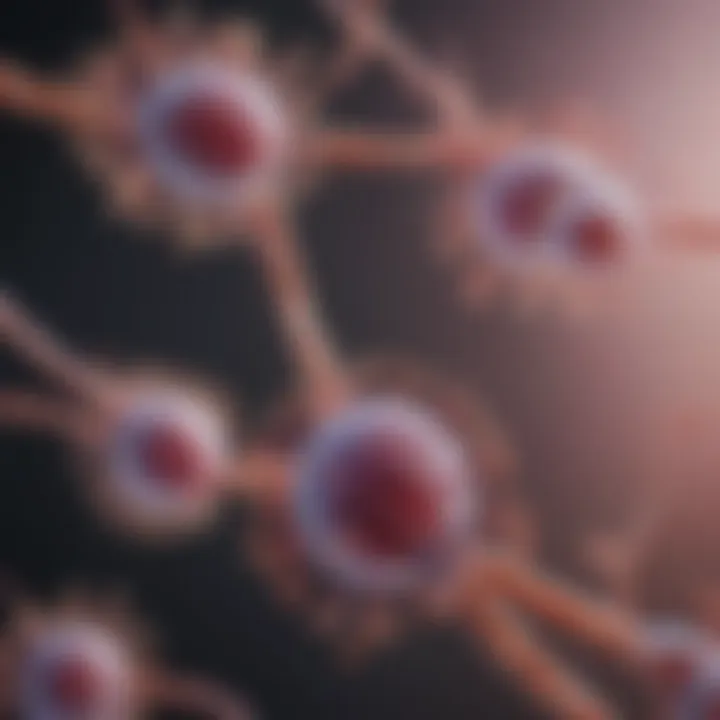RNAi Therapeutics: Innovations and Future Prospects


Intro
As the landscape of modern medicine continues to evolve, the focus on innovative approaches to gene regulation has gained immense traction. Among these advancements, RNA interference (RNAi) therapeutics have emerged as a powerful method in the arsenal of medical treatments. This article aims to illuminate the complexities of RNAi, spotlighting how its mechanisms can be harnessed to tackle various diseases by turning down the volume on specific genes.
At its core, RNAi is a natural biological process that cells use to regulate the activity of their genes. Researchers have recognized the potential for this process to be manipulated for therapeutic purposes. As we delve deeper, it's essential to understand not only the scientific underpinnings but also the substantial advancements that have been made in this field. The journey of RNAi therapeutics is still ongoing, marked by both significant successes and daunting challenges.
In the sections that follow, we will navigate these intricate themes—including the practical applications of RNAi, the technological innovations fostering its growth, and the hurdles that lie ahead in its therapeutic development. With a sharp focus on both current advancements and future potential, this article is tailored for students, researchers, educators, and professionals keen on understanding the state of RNAi therapy in contemporary medicine.
"RNA interference has opened the door to exciting possibilities in treating gene-related diseases—once thought nearly impossible to manage."
Throughout our journey, we will explore:
- The foundational mechanisms of RNAi
- Key advancements that have propelled RNAi therapeutics
- Challenges faced by researchers and clinicians in the field
- Future directions and potential applications in the medical realm
By unpacking these topics, we aim to provide a holistic view of RNAi therapeutics, illuminating both what has been accomplished and what remains to be explored.
Prologue to RNAi Therapeutics
In today's rapidly evolving landscape of molecular biology, RNA interference (RNAi) therapeutics have emerged as a pivotal element in the lexicon of modern medicine. Not just a fleeting trend, this innovative approach promises to revolutionize aspects of treatment and gene regulation. As the medical community grapples with complex diseases that persistently evade traditional therapies, RNAi stands as a beacon of hope, granted it tackles gene expression at its root. It's akin to sending a sniper rather than a shotgun into a battle; precise, targeted, and effective.
Definition and Overview of RNA Interference
At its core, RNA interference is a naturally occurring biological process whereby RNA molecules inhibit gene expression or translation. This mechanism serves as a critical regulatory function within cells, allowing for intricate control over gene activity. To put it simply, you can visualize RNAi as a set of finely tuned regulators deciding when and how much a particular gene should play its role.
In practical terms, RNAi involves small molecules called small interfering RNAs (siRNAs) and microRNAs (miRNAs). These agents essentially act like spies, intercepting messenger RNA (mRNA) before it can translate into protein, thus silencing specific genes. This process unveil a wealth of potential therapeutic avenues for addressing diseases ranging from cancer to genetic disorders. In an era where personalized medicine is gaining traction, RNAi stands poised to customize treatments tailored to individual genetic profiles.
Historical Context and Discovery
The journey of RNAi therapeutics is both fascinating and instructive. The foundational discovery can be traced back to a group of scientists who stumbled upon this intricate process in the late 1990s. Initially, the concept of gene silencing was unintentionally uncovered during experiments involving the introduction of double-stranded RNA into Caenorhabditis elegans, a common nematode. Researchers, including Andrew Fire and Craig C. Mello, noted that instead of enhancing gene expression as expected, the double-stranded RNA actually silenced the targeted gene. This serendipitous find garnered the duo the 2006 Nobel Prize in Physiology or Medicine, forever altering our understanding of genetic regulation.
As researchers began to unravel more about RNAi, its potential applications mushroomed. Early experiments swiftly transitioned from basic biology to the realm of therapeutics, sparking interest from both academia and industry. With this discovery, scientists started viewing RNAi not just as a biological curiosity, but as a powerful tool for fighting insidious diseases that contaminate human health.
The historical implications of RNAi and its subsequent advancements provide a solid backdrop as we venture deeper into the mechanisms, technologies, and applications that define RNAi therapeutics today. Each subsequent stride in understanding this methodology allows us to edge closer to the ambitious goal of curing diseases that were once considered intractable. The course set by early pioneers continues to resonate, offering ample promise for the future.
Mechanisms of RNA Interference
Understanding the mechanisms of RNA interference (RNAi) is crucial for comprehending how this transformative technology functions in gene regulation. RNAi operates as a natural cellular process that governs gene expression. This phenomenon is not only pivotal for basic biological regulation; it also provides significant therapeutic potential for tackling various diseases, ranging from cancer to viral infections.
The importance of RNAi mechanisms lies in their ability to silence specific genes, enabling targeted therapeutic strategies. This level of precision is unparalleled compared to conventional approaches that often lack specificity, leading to side effects. This section meticulously delves into the biochemical pathways, the role of small interfering RNA (siRNA), and microRNA (miRNA) functions, articulating the unique contributions they make to RNAi therapeutics.
Biochemical Pathways Involved in RNAi
The RNAi pathway intricately involves several biochemical components, primarily focusing on the processing and action of siRNAs and miRNAs. RNAi begins with the introduction of double-stranded RNA (dsRNA) into cells, which can arise from viral infections or experimental administration. The enzyme Dicer processes this dsRNA into shorter, approximately 20-25 nucleotide fragments of siRNA.
These siRNA fragments then bind to Argonaut proteins, forming the RNA-induced silencing complex (RISC). Upon binding, RISC condenses into a functional core that facilitates the unwinding of the siRNA strand, leading to the release of the passenger strand and retention of the guide strand. The guide strand then seeks out target messenger RNA (mRNA) sequences that are complementary, leading to cleavage and subsequent degradation of the mRNA. This process effectively reduces the translation of proteins encoded by those specific genes, thereby silencing them.
"RNA interference represents a fine-tuned regulation of gene expression that can be harnessed for therapeutic purposes, marking a shift in modern molecular medicine."
Role of Small Interfering RNA (siRNA)


Small interfering RNA, often abbreviated as siRNA, plays a the cornerstone role in the RNAi therapeutic landscape. Their primary function is to mediate the silencing of specific genes, making them invaluable tools in gene regulation. siRNA is synthesized either endogenously in response to viral infection or engineered for research and therapeutic applications.
The specificity and efficacy of siRNA can be tailored by adjusting the sequence to match the target mRNA sequence. This level of customization allows researchers to develop treatments for a wide array of diseases, particularly cancers where specific oncogenes are overexpressed. When strategically delivered into cells using various methods like lipid nanoparticles or conjugates, siRNA can induce significant reductions in the expression of these dysfunctional genes. The high potency of siRNA underscores its potential as a therapeutic agent.
MicroRNA (miRNA) Functions
MicroRNAs, or miRNAs, comprise another vital component of the RNAi mechanism. Unlike siRNAs, which originate as dsRNA, miRNAs are derived from longer transcripts and primarily function in regulating gene expression at the post-transcriptional level. They are typically embedded within introns of protein-coding genes or reside in non-coding regions. The biogenesis of miRNAs involves transcription by RNA polymerase II, which leads to the formation of primary miRNA (pri-miRNA). This pri-miRNA is then processed into a shorter miRNA precursor by the Dicer enzyme, similar to siRNA production.
MiRNAs exert their effects by binding to complementary sequences typically located in the 3' untranslated region (UTR) of target mRNAs. This binding does not necessarily lead to mRNA degradation, as seen with siRNA. Instead, miRNAs often inhibit the translation of the target mRNA, leading to decreased protein levels. This regulatory capability positions miRNAs as key players in various biological processes, including growth, differentiation, and stress responses. Moreover, dysregulation of miRNA expression has been implicated in numerous diseases, making them an attractive target for therapeutic intervention.
In summary, the mechanisms governing RNA interference, from the biochemical pathways to the roles played by siRNAs and miRNAs, establish a solid foundation for the therapeutic applications discussed throughout this article. By elucidating these mechanisms, we can better understand the profound implications of RNAi in modern medicine.
Technology Driving RNAi Therapeutics
The technology that powers RNAi therapeutics is a crucial element in shaping the future of gene regulation and precision medicine. The significance of this topic lies in its confluence of innovation, practicality, and impact on health outcomes. As researchers push the boundaries, they also explore various technological solutions that facilitate the administration of RNAi therapies more effectively. These advancements can potentially transform challenges into opportunities, addressing complex diseases that have long resisted conventional treatments.
Advancements in Delivery Mechanisms
When considering RNAi efficacy, the delivery mechanisms are as paramount as the therapeutic agents themselves. The main goal is to ensure that RNA molecules reach their intended cellular targets without degradation before they can function. Traditional methods have considerable limitations; hence, modern approaches are increasingly sophisticated. Recent developments focusing on better penetration of RNA species, specific binding, and reduced off-target effects are encouraging.
For instance, improvements in formulation strategies allow for encapsulation of RNA molecules in carriers that release the therapeutic agents in a controlled manner. This targeted delivery effectively increases cellular uptake and lowers potential toxicity. Advancements in microfluidics also aid in crafting nanoparticles with precise sizes that can stealthily navigate biological barriers.
Nanoparticle Utilization in RNA Delivery
Nanoparticles have emerged as game changers in the quest for efficient RNA delivery. These tiny structures come in various forms—lipid-based nanoparticles, polymeric nanoparticles, and gold nanoparticles, to name a few. Their versatility and customizable properties make them ideal carriers for siRNA and miRNA.
Using nanoparticles has several benefits:
- Stability: They protect RNA from enzymatic degradation, extending the therapeutic lifespan.
- Targeting: Modifications on nanoparticles can allow for specific targeting of diseased cells, minimizing the effect on healthy cells.
- Controlled Release: Nanoparticles can facilitate slow and controlled release of RNA, optimizing the therapeutic effect without overwhelming the cellular processes.
However, challenges remain. For instance, achieving the right size and surface characteristics to promote effective cellular uptake without triggering an immune response is essential and often tricky.
Viral Vectors for Targeted Delivery
Viral vectors play another pivotal role in the advancement of RNAi therapeutics. They naturally possess the ability to infect cells, which researchers harness to deliver therapeutic RNA. By modifying viruses, it’s possible to create vectors that specifically target diseased tissues while leaving healthy cells unharmed. This approach is particularly promising for treating genetic disorders and cancers.
Significant advantages of using viral vectors include:
- High Efficiency: They demonstrate a higher transfection efficiency compared to many non-viral methods.
- Long-lasting Effects: Certain viral vectors can integrate into the host genome, allowing for sustained gene silencing over time.
- Specificity: Their inherent ability to recognize and penetrate target cells makes them excellent for precision medicine.
Nonetheless, several cons need to be addressed, such as possible immune responses and the risk of insertional mutagenesis. Balancing efficacy with safety will be a determining factor for the future acceptance of viral vector-mediated RNAi therapies.
The synergy of novel delivery technologies and RNAi mechanisms holds the key to unlocking new therapeutic avenues, promising enhanced patient outcomes.
In summary, the technological advancements driving RNAi therapeutics are vital for the evolution of this field. Each innovative delivery strategy contributes to the improving precision and effectiveness in addressing the complexities of genetic and chronic diseases. Looking ahead, the fusion of various technologies promises to elevate RNAi therapeutics to meet the toughest medical challenges.
Current Applications of RNAi Therapeutics
The exploration of RNA interference (RNAi) therapeutics has broadened horizons in modern medicine. By enabling precise gene silencing, RNAi presents unique applications across various medical domains. The importance of understanding these applications lies in their potential to change how we approach the treatment of several difficult-to-manage diseases. For both researchers and clinicians, recognizing the significant benefits and challenges of these therapies is crucial as they work toward effective treatment solutions.


Cancer Treatment Approaches
Cancer, a leading cause of mortality worldwide, has seen promising advancements through RNAi technology. The ability to selectively silence oncogenes, which accelerate tumor growth, offers new avenues for therapeutic interventions. Researchers are studying the application of small interfering RNA (siRNA) to inhibit the expression of these aggressive genes.
For instance, in recent studies, siRNA molecules have been engineered to target the BCL-2 gene, known for its role in promoting cell survival and resistance to chemotherapy. By silencing this gene, tumor cells become more susceptible to conventional treatments. Beyond that, RNAi can also be tailored to target multiple genes simultaneously, presenting a rational approach to combat the complexity of cancer.
However, the journey isn't without bumps. One significant concern is the delivery mechanism of siRNA into the tumor environment. Ensuring that these therapeutics reach the intended cells while avoiding off-target effects is of utmost importance. Creative delivery solutions involving nanoparticles or viral vectors are being explored to tackle this issue.
Neurological Disorders and RNAi
The field of neurology represents another promising area for RNAi therapeutics. Conditions such as amyotrophic lateral sclerosis (ALS) and Huntington's disease, driven by genetic mutations, could benefit from RNAi interventions. By silencing harmful gene products, RNAi could potentially mitigate the progression of these neurological disorders.
Take, for example, the use of RNAi framework in targeting the HTT gene responsible for Huntington's disease. Preclinical models show that silencing the mutant HTT allele can lead to improved neuronal function and prolong survival in affected organisms. These approaches are still under research, but the insights derived from them reflect a noteworthy shift towards genetic targeted therapies.
Nevertheless, the delivery of RNAi in the central nervous system is challenging. The blood-brain barrier presents a formidable obstacle, complicating the introduction of RNAi treatments. Developing methods to overcome this barrier remains a hot topic in ongoing research.
Antiviral Strategies Utilizing RNAi
In the realm of infectious diseases, RNAi holds promise as a powerful antiviral strategy. The technology can effectively silence viral genes, disrupting the replication process and stifling the ability of viruses to spread within the host.
HIV, for instance, has emerged as a focal point for RNAi researchers. Therapeutic applications targeting HIV's integration into host DNA demonstrate considerable potential, leading to inhibited viral replication and reduced viral load. Similarly, various studies are investigating the use of RNAi against Hepatitis B and C viruses, paving the way for innovative antiviral treatments.
Yet, key hurdles remain. Achieving effective and safe delivery to infected cells is paramount, alongside ensuring that the antiviral RNA doesn’t inadvertently trigger immune responses that could cause harm.
In summary, RNAi therapeutics breathe new life into treatment strategies across various domains in modern medicine. From cancer therapies to neurological disorders and antiviral treatments, the promise of tailored gene silencing could very well reshape our approach to tackling diseases that have long posed considerable challenges.
Challenges in RNAi Therapeutic Development
The advancement of RNA interference (RNAi) therapeutics has indeed been a game-changer in the field of medicine, but it's not all smooth sailing. Challenges in RNAi therapeutic development often loom large, affecting everything from research and trial phases to the ultimate approval and application in clinical settings. Understanding these barriers is crucial because they play a significant role in determining how quickly and effectively new therapies can reach patients. Let's dive deeper into some of the complexities involved in this burgeoning area of science.
Off-Target Effects and Specificity Issues
One of the notable hurdles in RNAi therapeutic development is the phenomenon of off-target effects. Simply put, when a treatment meant to silence a specific gene inadvertently affects others, it can lead to unintended consequences. This lack of specificity not only hampers efficacy but may also induce adverse effects that complicate treatment outcomes.
- Importance of Precision: The quirks of gene expression mean that tight regulation and targeting are paramount. The fewer unrelated genes that get silenced, the lower the risk of side effects.
- Biological Complexity: The human genome is intricate, with many genes sharing similar sequences, making it tricky to design RNAi molecules that won't latch on to unintended targets.
Achieving precision in targeting necessitates cutting-edge technologies and methods, such as improved design algorithms and verification through high-throughput screening, to better predict off-target interactions. Researchers use bioinformatics tools to predict off-target effects and rely on refined delivery systems to enhance specificity.
Immune Responses to RNAi Therapeutics
Another significant challenge arises from the immune system's responses to RNAi therapeutics. The body is designed to recognize foreign substances, and sometimes, RNA molecules are perceived as threats, initiating an immune reaction. This can severely undermine the efficacy of RNAi treatments and lead to complications.
- Type of Immune Response: Cytotoxic T cells may become activated, resulting in the destruction of not just the modified cells but possibly normal cells as well. An overactive immune response can limit the duration of therapeutic effects.
- Mitigation Strategies: Not all RNAi therapeutics invoke strong immune reactions, but those that do often require clever engineering. Chemical modifications to the RNA molecules can bolster their resilience against immune detection.
Furthermore, selecting lipid nanoparticles for delivery can also help. These carriers can be crafted to evade the immune system while ensuring the proper uptake of RNAi molecules into target cells.
Regulatory Challenges in Approval Processes
Navigating the regulatory landscape is often like walking a tightrope for RNAi therapeutics. Regulatory bodies need to ensure that therapies are both safe and effective, but the novel nature of RNAi brings its own set of issues.


- Complexity of Trials: Clinical trials for RNAi therapeutics can be intricate. They often need larger datasets to accurately assess long-term effects and off-target impacts. Gaining regulatory approval means conducting exhaustive studies that can be costly and time-consuming.
- Need for Clear Guidelines: As this field is still relatively new, clear and comprehensive regulatory guidelines are still in flux. Companies developing RNAi therapeutics may find themselves in over their heads trying to navigate these evolving rules.
This is crucial; the clearer the regulatory framework becomes, the more streamlined the development process will be, allowing innovative therapies to reach the market without unnecessary delays.
"The future of RNAi therapeutics hinges on addressing these challenges head-on, paving the way for a new era in gene-based medicine."
Ultimately, while the challenges in RNAi therapeutic development are significant, they are not insurmountable. Grasping the nuances of off-target effects, combatting immune responses, and navigating regulatory mazes will be essential in unlocking the full potential of RNAi as a therapeutic avenue in modern medicine.
Future Directions in RNAi Therapeutics
The field of RNA interference (RNAi) therapeutics is poised at the edge of transformation. As researchers are continuously exploring new frontiers, understanding the future directions in RNAi can not only guide ongoing studies but also shape the future of medicine itself. The significance of advancing RNAi therapeutics lies in its potential to provide innovative solutions for conditions that currently lack effective treatments.
Next-Generation Gene Silencing Technologies
The next generation of gene silencing technologies promises to enhance the specificity and efficacy of RNAi. Researchers are delving into novel RNAi molecules, such as external guide sequences and CRISPR-based systems, which offer more precision. These systems can better target specific gene sequences and silence them without affecting neighboring genes. This precision is essential as it minimizes unintended side effects, often referred to as off-target effects, a significant concern in the earlier generations. Such advancements could lead to treatments that are not only more effective but also safer for patients.
Another exciting pathway includes the development of new formulations that enable better delivery of the siRNA molecules to target tissues. For instance, biodegradable polymers that facilitate sustained release of RNAi therapeutics could dramatically improve treatment outcomes. This approach not only ensures that the therapeutic agents reach their destinations effectively but also contributes to a reduction in systemic toxicity, making therapies more tolerable for patients.
Integration with Other Therapeutic Approaches
Integrating RNAi with other therapeutic modalities can significantly amplify its impact. Combining RNAi with existing treatment strategies, like chemotherapy or immunotherapy, opens new avenues for enhancing therapeutic responses and overcoming resistance mechanisms commonly seen in diseases such as cancer. For example, using RNAi to silence genes responsible for drug resistance could augment the efficacy of chemotherapeutics.
Moreover, leveraging RNAi in conjunction with small molecule inhibitors or monoclonal antibodies might provide synergistic effects, making it possible to achieve better outcomes in complex diseases. This multi-faceted approach could be particularly beneficial in treating relapsed or refractory cancers, where conventional treatments may fail.
Personalized Medicine and RNAi Applications
Personalized medicine is transforming the landscape of healthcare, and RNAi is no exception. By tailoring RNAi therapeutics based on individual genetic profiles, clinicians can optimize treatment strategies for specific patient populations. There is an ongoing effort to develop biomarkers that can predict responses to RNAi treatments, thus enabling more informed clinical decisions.
For instance, patients with specific mutations might benefit from tailored siRNA that targets the mutated genes directly. This level of customization ensures that the right therapy reaches the right patient, which is a fundamental goal of modern medicine. It also enhances the risk-benefit ratio of introducing RNAi applications into treatment regimens.
The evolutionary journey of RNAi therapeutics underscores the excitement and promise embedded within this field. Through next-generation technologies, integration with varied therapeutic strategies, and a keen focus on personalized treatment regimens, RNAi stands ready to carve pathways that were once deemed out of reach.
"In the quest for advanced treatment options, RNAi therapeutics encapsulate a scientific revolution that could redefine our approach to managing complex diseases, making personalized care a tangible reality."
As we move forward, continued research and collaborative efforts among scientists, clinicians, and biopharmaceutical companies will be crucial in realizing the full potential of RNAi therapeutics.
End
As we step back and look at the landscape of RNAi therapeutics, it’s clear that the promise held in this realm is profound, not just for the scientific community but for patients everywhere. The journey of RNA interference has taken us from the realm of theoretical biology into the depths of practical application. This transition underpins why the conclusion of our discourse is so essential. Let’s delve into a few key elements that underscore the significance of this conclusion in the context of our article.
Summary of RNAi Therapeutics Potential
The potential of RNAi therapeutics comprises various dimensions:
- Precision Gene Regulation: RNAi allows for the tailored silencing of specific genes implicated in diseases, making treatments more targeted and minimizing collateral damage to healthy cells.
- Broad Applicability: From oncology to viral infections, RNAi spans a swath of medical disciplines, showing its versatility in addressing complex health challenges.
- Emerging Technologies: Innovations in delivery systems and formulations are continually boosting the efficacy and safety of RNA-based therapies.
With these facets in mind, it’s evident that the horizon for RNAi therapeutics is not just a straight path; it’s a landscape filled with peaks and valleys of discovery and advancement.
Call to Action for Continued Research
For the momentum to carry forward, continuous research is crucial. Here are some reasons why:
- Further Understanding of Mechanisms: Exploring the nuances of RNAi processes will enable greater therapeutic advancements.
- Overcoming Challenges: By addressing current obstacles like off-target effects and immune responses, future studies can lead to safer and more efficacious treatments.
- Integration with Personalized Medicine: Continued research could pave the way for individualized therapies that match the specific genetic profiles of patients.
The path forward is ripe with opportunity, and as both researchers and practitioners step up to the plate, the collective ambition must be to push the boundaries of what RNAi can achieve. The future isn’t just a mere possibility; it’s a canvas waiting for the strokes of innovation.



